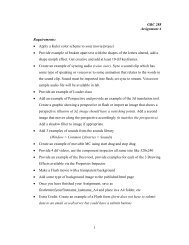Introducing Financial Accounting - CCSN Computer Graphics Program
Introducing Financial Accounting - CCSN Computer Graphics Program
Introducing Financial Accounting - CCSN Computer Graphics Program
You also want an ePaper? Increase the reach of your titles
YUMPU automatically turns print PDFs into web optimized ePapers that Google loves.
wiL27041_ch01_002-047.indd Page 29 10/7/10 2:41:31 PM user-f499 /Volumes/204/MHBR211/wiL27041_disk1of1/0073527041/wiL27041_pagefiles<br />
Chapter 1 <strong>Introducing</strong> <strong>Financial</strong> <strong>Accounting</strong> 29<br />
A list of key terms with page references concludes each chapter (a complete glossary is at the end of the book and also on the book’s Website).<br />
Key Terms mhhe.com/wildFAF3e<br />
<strong>Accounting</strong> (p. 4)<br />
<strong>Accounting</strong> equation (p. 14)<br />
Assets (p. 14)<br />
Audit (p. 12)<br />
Auditors (p. 13)<br />
Balance sheet (p. 19)<br />
Bookkeeping (p. 4)<br />
Business entity assumption (p. 11)<br />
Common stock (p. 12)<br />
Conceptual framework (p. 9)<br />
Contributed capital (p. 14)<br />
Corporation (p. 12)<br />
Cost-benefit constraint (p. 12)<br />
Cost principle (p. 10)<br />
Dividends (p. 14)<br />
Equity (p. 14)<br />
Ethics (p. 8)<br />
Events (p. 15)<br />
Expanded accounting equation (p. 14)<br />
Expense recognition principle (p. 11)<br />
Expenses (p. 14)<br />
External transactions (p. 15)<br />
External users (p. 5)<br />
<strong>Financial</strong> accounting (p. 5)<br />
<strong>Financial</strong> <strong>Accounting</strong> Standards Board<br />
(FASB) (p. 9)<br />
Full disclosure principle (p. 11)<br />
Generally accepted accounting principles<br />
(GAAP) (p. 8)<br />
Going-concern assumption (p. 11)<br />
Income statement (p. 19)<br />
Internal transactions (p. 15)<br />
Internal users (p. 6)<br />
International <strong>Accounting</strong> Standards<br />
Board (IASB) (p. 9)<br />
International <strong>Financial</strong> Reporting<br />
Standards (IFRS) (p. 9)<br />
Liabilities (p. 14)<br />
Managerial accounting (p. 6)<br />
Matching principle (p. 11)<br />
Materiality constraint (p. 12)<br />
Measurement principle (p. 10)<br />
Monetary unit assumption (p. 11)<br />
Net income (p. 14)<br />
Net loss (p. 14)<br />
Additional Quiz Questions are available at the book’s Website.<br />
Partnership (p. 11)<br />
Proprietorship (p. 11)<br />
Recordkeeping (p. 4)<br />
Retained earnings (p. 14)<br />
Return (p. 26)<br />
Return on assets (p. 22)<br />
Revenue recognition principle (p. 10)<br />
Revenues (p. 14)<br />
Risk (p. 26)<br />
Sarbanes–Oxley Act (p. 12)<br />
Securities and Exchange Commission<br />
(SEC) (p. 9)<br />
Shareholders (p. 12)<br />
Shares (p. 12)<br />
Sole proprietorship (p. 11)<br />
Statement of cash flows (p. 19)<br />
Statement of retained earnings (p. 19)<br />
Stock (p. 12)<br />
Stockholders (p. 12)<br />
Time period assumption (p. 11)<br />
Multiple Choice Quiz Answers on p. 47 mhhe.com/wildFAF3e<br />
1. A building is offered for sale at $500,000 but is currently assessed<br />
at $400,000. The purchaser of the building believes the<br />
building is worth $475,000, but ultimately purchases the building<br />
for $450,000. The purchaser records the building at:<br />
a. $50,000<br />
b. $400,000<br />
c. $450,000<br />
d. $475,000<br />
e. $500,000<br />
2. On December 30, 2010, KPMG signs a $150,000 contract to<br />
provide accounting services to one of its clients in 2011. KPMG<br />
has a December 31 year-end. Which accounting principle or<br />
assumption requires KPMG to record the accounting services<br />
revenue from this client in 2011 and not 2010?<br />
a. Business entity assumption<br />
b. Revenue recognition principle<br />
c. Monetary unit assumption<br />
d. Cost principle<br />
e. Going-concern assumption<br />
3. If the assets of a company increase by $100,000 during the<br />
year and its liabilities increase by $35,000 during the same<br />
year, then the change in equity of the company during the year<br />
must have been:<br />
a. An increase of $135,000.<br />
b. A decrease of $135,000.<br />
c. A decrease of $65,000.<br />
d. An increase of $65,000.<br />
e. An increase of $100,000.<br />
4. Brunswick borrows $50,000 cash from Third National Bank.<br />
How does this transaction affect the accounting equation for<br />
Brunswick?<br />
a. Assets increase by $50,000; liabilities increase by $50,000;<br />
no effect on equity.<br />
b. Assets increase by $50,000; no effect on liabilities; equity<br />
increases by $50,000.<br />
c. Assets increase by $50,000; liabilities decrease by $50,000;<br />
no effect on equity.<br />
d. No effect on assets; liabilities increase by $50,000; equity<br />
increases by $50,000.<br />
e. No effect on assets; liabilities increase by $50,000; equity<br />
decreases by $50,000.









